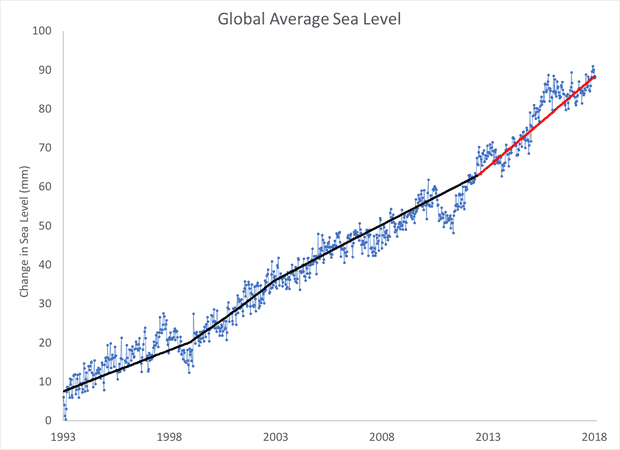
There’s recently been a spate of sea level rise denial in the conservative media, but in reality, sea level rise is accelerating and melting ice is playing an increasingly large role. In the first half of the 20th Century, average global sea level rose by about 1.4 millimeters per year (mm/yr). Since 1993, that rate has more than doubled to 3.2 mm/yr. And since 2012, it’s jumped to 4.5 mm/yr.

Global mean sea level data from the Colorado University Sea Level Research Group, with 4-to-5-year linear trends shown in black and red. Illustration: Dana Nuccitelli
Thermal expansion (ocean water expanding as it warms) continues to play the biggest role in sea level rise, but its contribution of about 1.3 mm/yr is now responsible for a smaller proportion of total sea level rise (30% in recent years) than its contribution since the 1990s (40% of the total). That’s because of the acceleration in melting ice.
Glacier melt is accelerating, recently contributing about 0.75 mm/yr to sea level rise, up from 0.65 mm/yr since the 1990s. But the biggest jumps have come from ice in Greenland and Antarctica. Greenland had been responsible for about 0.48 mm/yr sea level rise since 1990, but in recent years is up to 0.78 mm/yr. A recent study in Nature Climate Change found that Greenland contributed about 5% to sea level rise in 1993 and 25% in 2014.
Another recent paper published in Earth’s Future found that rapid losses from Antarctic ice are plausible. The study found that in moderate to high carbon-emission scenarios, an average expected sea level rise of 2 to 2.5 feet by 2100 could actually become 3 to 5 feet once Antarctic ice sheet dynamics are taken into account.
The vast majority of Antarctica’s current ice loss is coming from West Antarctica, where about 75% of the glaciers are located below sea level. In East Antarctica, which has so far remained stable, only about 35% of the glaciers are below sea level. Warming ocean waters are melting the Antarctic ice from below, which is particularly problematic for that low-lying ice in West Antarctica. Research suggests that the collapse of the Western Antarctic ice sheet is already unstoppable.

The amount of ice loss across Antarctica in total (purple), and in West Antarctica (green), East Antarctica (yellow) and the Antarctic Peninsula (red). Illustration: Shepherd et al. (2018), Nature
Short-term variations in sea level rise do happen. Sea level actually briefly fell in 2010 due to a strong La Niña cycle, which typically results in an increase of rain and snow falling over land. This resulted in a number of epic deluges and flooding across the globe; more water on land temporarily meant less in the ocean.
However, Antarctica and Greenland could potentially cause rapid sea level rise. As James Hansen explains in the video below, there have been periods in the not-so-distant past when sea levels rose at an average rate of 1 meter every 20 years.
Posted by dana1981 on Monday, 18 June, 2018
 |
The Skeptical Science website by Skeptical Science is licensed under a Creative Commons Attribution 3.0 Unported License. |